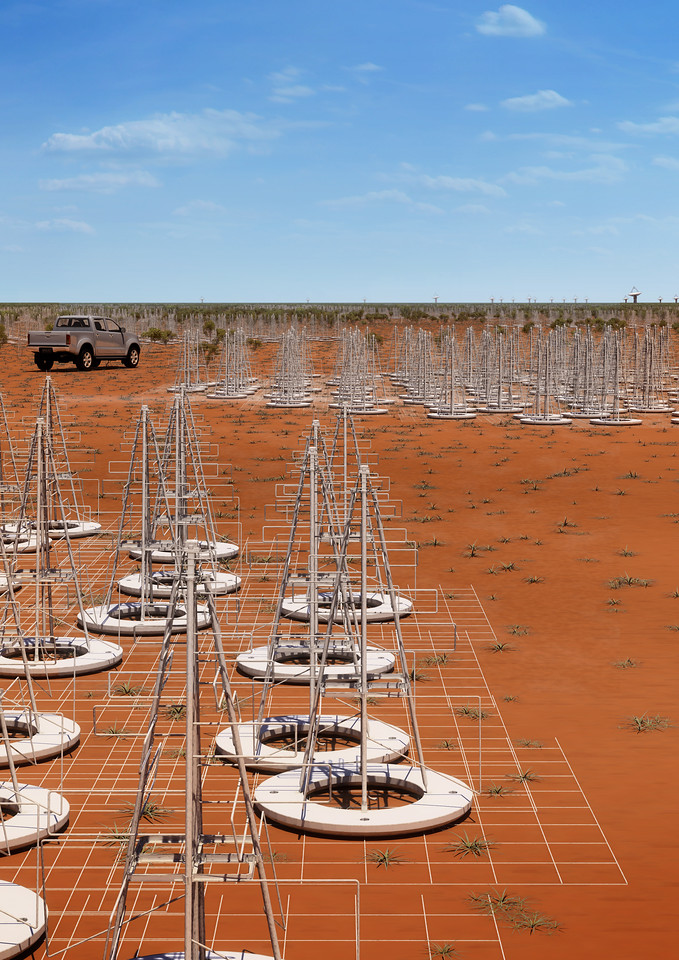SKA start marked
 Construction of the world’s largest radio astronomy observatory, the SKA Observatory (SKAO), has begun.
Construction of the world’s largest radio astronomy observatory, the SKA Observatory (SKAO), has begun.
Ceremonies have been held at future Square Kilometre Array (SKA) sites in Australia and South Africa.
The SKA telescopes will initially comprise 131,072 antennas in Australia (SKA-Low), which will be built at Inyarrimanha Ilgari Bundara, the CSIRO Murchison Radio-astronomy Observatory on Wajarri Country in Western Australia, and 197 dishes in South Africa (SKA-Mid), to be built in the Karoo in South Africa.
Together, the SKA telescopes will provide an unparalleled view of the Universe and be one of the biggest science facilities on Earth.
Among its many science goals, SKA-Low will explore the first billion years after the so-called ‘dark ages’ of the Universe, when the first ever stars and galaxies were forming. It will map the structure of the infant Universe for the first time, enabling scientists to watch the births and deaths of the first stars, and help the world to understand how the earliest galaxies formed.
“The SKA telescopes will be sensitive enough to detect an airport radar on a planet circling a star tens of light years away, so may even answer the biggest question of all: are we alone in the Universe?” said Dr Sarah Pearce, SKA-Low Telescope Director and head of telescope operations in Australia.
To put the sensitivity of the equipment into perspective, the SKA could detect a mobile phone in the pocket of an astronaut on Mars, 225 million kilometres away.
More excitingly, if there are intelligent societies on nearby stars with technology similar to ours, the SKA could detect the aggregate ‘leakage’ radiation from their radio and telecommunication networks - the first telescope sensitive enough to achieve this feat.
The tremendous sensitivity of the SKA will allow astronomers to peer back billions of years to 'Cosmic Dawn': the epoch when the first stars in the Universe were forming.
“The SKA Observatory’s telescopes will be one of humanity’s biggest-ever scientific endeavours. I have been involved with the SKA project for the past 30 years, so to finally see the start of on-site construction is a momentous occasion,” says SKAO Director-General Professor Philip Diamond.
“We are thrilled to be working with the Australian government, a founding member of the Observatory; CSIRO, our operations partner in Australia; and our Australian collaborators on a shared journey of discovery, innovation and progress.
“We are truly grateful to the Wajarri Yamaji for agreeing to host the telescope on their land. We honour their willingness to share their skies and stars with us as we seek to find answers to some of the most fundamental science questions we face. And we commit to respecting their connection to the land, and preserving and protecting their cultural heritage.”
Federal science minister Ed Husic says Australians should be proud of the country’s involvement in this project.
“This is a historic day, and I am sure we will see many breakthroughs result from the SKA project,” Mr Husic said.
“The cutting-edge technology for the SKA telescopes will expose Australian businesses to new skills and capabilities. We will see these changes flow on to benefit the community, the businesses involved in the project, and Australia, more broadly, for generations to come.”
In Australia, the SKAO will collaborate with CSIRO, Australia’s national science agency, to build and operate the telescopes.
CSIRO’s Executive Director of Digital, National Facilities and Collections, Professor Elanor Huntington, says the benefits of the SKAO are not limited to astronomy.
“Much of the technology and engineering required for the telescope to work need to be developed for the first time,” Professor Huntington said.
“These advances in engineering, signal processing and computing will not only benefit the astronomy community, but Australian industry as we move further into our data-driven future.
“The SKAO’s telescopes are providing an opportunity for Australians to innovate and share with the global community. We’re all coming together to not only learn more about the Universe but drive advances in data handling and signal processing.”
Dr Douglas Bock - Director of Space and Astronomy at CSIRO - says the scientific world is waiting.
“The SKA-Low telescope will be a leap ahead of current technology and allow an unprecedented view of the Universe with incredible sensitivity, which will allow us to observe the distant Universe in much more detail than anything we've done so far,” he said.
“SKA-Low is being built far from large population centres and away from contaminating signals from mobile phone towers and radio stations.
“Inyarrimanha Ilgari Bundara, the CSIRO Murchison Radio-astronomy Observatory where the SKA-Low telescope is being built on Wajarri Country is perhaps the best site for low-frequency astronomy anywhere on Earth.
“The latest digital technology also means SKA-Low will look at a large part of the sky all at once. It will speed up discovery – we’ll have a much higher chance to discover new phenomena.
“So many of the most exciting discoveries in astronomy have been found when we built new powerful telescopes and just went looking!”








 Print
Print